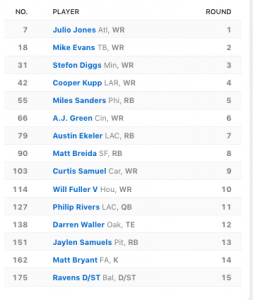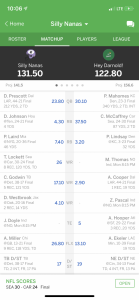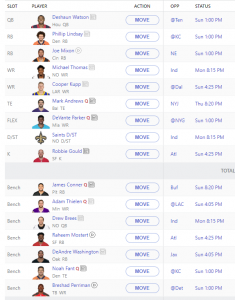2019 Zero RB Candidates Countdown: No. 10 to No. 6
Twitter
Facebook
Welcome to the 2019 Zero RB target list where we help you find inexpensive RBs to destroy your league. The list isn’t just for Zero RB owners. You can use the list to construct a Zero RB squad, to fill out your 1-Elite-RB roster, or to build Flex upside into a RB-heavy start.
With his 2018 picks hitting at a high rate, Shawn won his 11th high-stakes league at the Main Event level or higher and added to his double-digit totals in top-15 national finishes. The Zero RB selections also helped him snag his third MFL10 of Death title in four years.
In Part 1, we counted down the candidates from No. 15 to No. 11 and presented Zero RB evidence for 2019 that will pique the interest of the most hardened Robust RBers.
We also took a brief look at the Zero RB lists of yore and their breakout stars, including
Devonta Freeman (
2015),
Melvin Gordon (
2016),
Kareem Hunt and
Alvin Kamara (
2017).
It would seem impossible to top those results, but the list managed it in 2018.
Jump back to Part 1 for that discussion and the full intro or zoom ahead to
The List to see who shows up in Part 2.
The List
As long-time readers know, these will be arranged in order of ADP, starting with the least expensive. Between Rounds 6 and 18 in each individual draft, you’ll want to select six or seven of the 15 targets. This provides enough flexibility to let the best values fall to you.
No. 10 Justin Jackson
Earlier this offseason I called Jackson a
chimera fashioned from
Christian McCaffrey’s body,
Aaron Jones’ profile, and
James Conner’s status as a handcuff who could emerge as an RB1. He’s even got a bit of
Phillip Lindsay in his collegiate resume, with the caveat that Jackson was more prolific.
That may seem like hyperbole, but hyperbole would be saying that Jackson is going to score like McCaffrey this season. He’s not. The other comparisons really do stand.
Jackson is the second-closest physical comp for McCaffrey, according to the
Combine Explorer.
Aaron Jones is his No. 1 production/athleticism comp by the
Box Score Scout.
And frequent readers know we championed Lindsay last year due to his No. 1 ranking in the Backfield Dominator Rating, but Jackson brought the production on an entirely different level.
Jackson went over 1,000 yards rushing in every season, starting as a freshman. But that’s just the beginning. He also caught 122 passes for 858 receiving yards. The Northwestern star gained 6,298 career yards from scrimmage and crested 1,350 every year.
These are wildly impressive numbers through any lens. The totals are crazy, the final year numbers are crazy, and the early breakout is impressive.2 While Lindsay led in final-year Workhorse Score, Jackson’s first-year Workhorse Score of 69 slid in right between Royce Freeman (76) and Saquon Barkley (61). Jackson was also third in the class in career Workhorse Score, right behind Barkley.
Why I Like Jackson: Jackson impressed in limited touches as a rookie but now faces a couple of hurdles. 1) He’ll start the season behind the
most explosive space back in the game. 2) Despite the threats and rhetoric, it’s likely a matter of when, and not if,
Melvin Gordon eventually returns. Fortunately for Jackson, he falls outside the ADP range where you can draft a stud WR. That’s important since Jackson will likely begin the season on the short end of a 60-40 split with
Austin Ekeler.
No. 9 Jaylen Samuels
No one on this year’s list checks as many total boxes as Samuels.
He was a high-value touch machine at N.C. State where he went over 1,800 yards
receiving and scored 46 total TDs.
That only scratches the surface. He was the poster boy for our look at
The Surprisingly Simple Way to Select Second-Year Breakout RBs. Blair Andrews tell us that runners who generate positive numbers in rookie-year fantasy points over expectation (FPOE) go on to
much better sophomore seasons.
Samuels led the rookie class with 19.4 receiving FPOE, giving him great numbers despite the mild rushing blemish (-4.5).
Why I Like Samuels: Last year James Conner did an Oscar-caliber turn as
Le’Veon Bell, but Samuels might actually be more Bell than Bell.
Ryan Collinsworth fired up the Projection Machine and came to the conclusion that a conservative estimate for Samuels – assuming full health from Conner – would still give him 159 fantasy points, or good for a top-30 finish the last two seasons. If anything happens to the incumbent, Samuels would immediately offer more upside than Conner does now. He’ll lose some early-down work to the underrated
Benny Snell. But while Conner is set to lose high-value touches to Samuels, the second-year sleeper would lose mostly low-value touches to the rookie.
No. 8 Ronald Jones
Jones is now dealing with swelling in his left knee. This looks like the straw that broke the camel’s back for drafters, as his ADP is quickly plummeting out of the late single-digit rounds. If your goal is simply to own Jones on the cheap and see how this backfield develops a month into the season, well, that’s the silver lining.
I’ve written several thousand
cautiously optimistic words on Jones that boil down to a handful of key points:
- Draft slot – He was selected three picks after Nick Chubb and five picks before Kerryon Johnson.
- Athleticism – Jones was hurt at the combine, but other reported timings suggest he’s one of the fastest backs in the NFL.
- Collegiate production – As bad as Jones was for the Bucs last year, he was that good at Southern Cal.
This combination gave him impressive comps.
If you give him his true 40 time, he starts to look more like
Jamaal Charles.
In that piece I also explained that while Jones’ struggles were extreme, they were not unique. The list of disappointing rookie RBs who went on to big second seasons includes the aforementioned Charles, but also guys like Shaun Alexander, Brian Westbrook, and Larry Johnson.
Early-round busts receive multiple opportunities to prove themselves:
In a recent stroll through memory lane, I stumbled across a couple of relevant articles by the Fantasy Douche. Opportunity Knocks Twice for NFL RBs discusses the necessity GM’s feel to make their picks look good. “Draft position was actually more explanatory for an RB’s second year carries than it was for his first year carries. There might be both buy low and sell high opportunities that come from this information.”
Why I Like Ronald Jones: Of all the backs on the list this year, Jones is the easiest to hate. In that way, he’s similar to names like Darren McFadden, and C.J. Spiller when they erupted for their fleeting star turns.
1 I like Jones because it’s fun to have at least one name on the list who really takes guts to pick.
No. 7 Matt Breida
Breida comes in at the opposite end of the spectrum. He’s the former undrafted free agent who’s been so good there’s no way to keep him off the field.
Breida may not have the impossible, video-game stutters of a Barry Sanders or the preternatural vision and first-step quickness of a Jamaal Charles, but he was a ghost last season, a literal blur on the field at a fraction of full health. If all goes according to plan this year, his athleticism will start to take on the hint of myth as well. He’s a freak: 4.39 forty, 42-inch vertical, 6.85 three-cone.
Tevin Coleman is one of the best athletes at the position in the NFL, and he doesn’t come close to that.
Despite playing for a broken down jalopy of an offense in 2018, Breida joined Lindsay, Gordon, McCaffrey,
Nick Chubb, and
Saquon Barkley as the only backs to average at least 5.0 yards per carry on 150 or more attempts. He also took a big step as a receiver, posting more than 20 reFPOE on limited looks.
Why I Like Matt Breida: In 2016, Coleman averaged 14.7 PPG playing second fiddle to
Devonta Freeman. We don’t even know that Breida will definitely be the No. 2. His enthusiasts will argue that he profiles more as an explosive version of Freeman. Perhaps he’ll be the Kyle Shanahan runner who finishes as the RB6 instead of the RB20. Either way, he’s a value.
No. 6 Kalen Ballage
“Ballage at RB40” is the answer to the question: Where do you draft an RB who is a fantastic athlete yet not a skilled runner but who plays behind another RB with those exact same qualities … who also happens to be injured?
I’m very conflicted about Ballage. The players you see on this list destroyed their collegiate competition to a man. We look at a lot of raw and advanced stats when compiling the Zero RB candidates list, but in one important way, it all boils down to something simple. Production translates. If you want to draft from the pool of RBs who will see a five-to-eight round jump in their ADPs next season, just ask yourself: Who’s fast, annihilated college, and is cheap because he’s a first- or second-year player who hasn’t proven himself at the NFL level yet?
With Ballage, we have to make excuses, and those excuses tend to leave us with bad football players. If you didn’t draft an RB early and now you’re sifting for late-round gold, you don’t want bad football players.
However, after all that, the justifications are interesting.
Ballage runs a 4.46 forty and turned in a sub-7.0 three-cone at 228 pounds. That’s a three-down body, and the all-important receiving game is not where Ballage struggles. He caught 44 passes as a junior at Arizona State and scored 37% of his (limited) rookie points through the air.
Moreover, Ryan Collinsworth, in his fantastic series on game script, explains why playing for a moribund Dolphins offense is actually
much better for his fantasy prospects than you might think.
His ADP also places him in “Zero RB Shangri La” — a metaphorical oasis of Zero RB talent available on teams with low preseason Vegas win totals. This group of running backs (ADP RB37 to RB4 boasts elite production relative to their ADP, with an average end-of-season PPR RB finish of 28.7.
Why I Like Ballage:
boasts elite production relative to their ADP, with an average end-of-season PPR RB finish of 28.7.
Why I Like Ballage: He fits the profile of an RB who could
quickly vault from RB3 to RB1, and he’s available in the
Priority RB Window.
* If you missed the discussion of the Priority RB Window in Part 1, please make sure you jump over there and learn why Blair Andrews’ Win the Flex app is the key to understanding where you should target the RB position.
Zeroing in on the last month, the
FFPC Redraft Dashboard shows the rise of Ballage and Breida contrasted with the fall of Jones. Be sure to plan your draft tactics accordingly.
Stay tuned for Part 3 where we count down the top-five Zero RB candidates for 2019.
Image Credit: Robin Alam/Icon Sportswire. Pictured: Matt Breida.
bishopstrongbow I know Jacobs is poised to.







 boasts elite production relative to their ADP, with an average end-of-season PPR RB finish of 28.7.
boasts elite production relative to their ADP, with an average end-of-season PPR RB finish of 28.7.






































